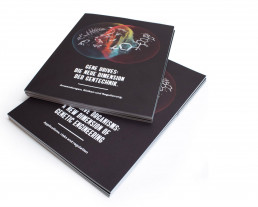
Gene drive organisms are perhaps one of the most dangerous environmental applications of genetic engineering ever developed.
The Stop Gene Drive campaign aims to prevent the release of genetically engineered gene drive organisms into the wild.
A representative survey reveals:
Majority of citizens from 8 EU-countries consider the release of gene drive organisms too risky
EU citizens are calling on EU environmental ministers to prevent the release of gene drive organisms into the environment.
NGOs around the world call for gene drive moratorium
Gene Drives: The chain reaction
that genetically engineers wild species.
Enabled by new tools for genetic engineering called CRISPR/Cas, sexually reproducing animals and plants can be genetically manipulated in a way as to pass on a new trait to all their offspring – even if this trait proves to be fatal for them. This overrides the natural rules of inheritance. This mechanism is then repeated independently in each new generation, resulting in a risky and uncontrollable genetic chain reaction.
Gene Drive Organisms are supposed to replace or even exterminate their conspecifics in nature. Their future environmental release could have unforeseeable and irreversible consequences for ecosystems and food webs. In the worst case, this could lead to further species extinction and the collapse of entire ecosystems, as well as endangering human health and food security.
The differences between old and new genetic engineering techniques are based on the tools and mechanisms used in the process, as well as the possibility of targeting the sites of DNA changes and the type of the desired genetic modification.
‘Old genetic engineering techniques’ refer to procedures that introduce one or more genes of either the same or a foreign species into the DNA of an organism using bacterial plasmids or gene guns. The incorporation of inserted DNA in the genome thereby is left to chance.
‘New genetic engineering techniques” are based on methods such as CRISPR/-Cas, zinc finger nuclease or Talens. They too need to be introduced into the cell, before they can become active in its DNA. These methods have been dubbed “gene scissors” because they enable DNA sequences to be cut at a targeted site. The resulting cellular repair mechanisms are then used by biotechnologists to either knock out individual genes, to alter their function or to insert new gene sequences.
CRISPR/Cas is a so-called ‘new’ genetic engineering technique discovered in 2012 by molecular biologists Emanuelle Charpentier and Jennifer Doudna. CRISPR is an acronym for Clustered Regularly Interspaced Short Palindromic Repeats. Bacteria use CRISPR sequences as a way to remember and prevent attacs from viruses as part of their immune system. Doudna and Charpentier then turned this mechanism into a tool for biotechnology. CRISPR consists of two components: a DNA sequence search tool and an associated protein, called Cas (which is an abbreviation for CRISPR-associated). Cas can perform a double-strand break at a specific DNA target sequence. Repair mechanisms in the cell can mend this in three ways. Biotechnologists exploit these three repair mechanisms to either knock out existing gene sequences, insert only a single base pair, or insert an entirely new DNA sequence.
The term ‘mutagenic chain reaction’ was coined by gene drive inventors Valentino Gantz and Ethan Bier. When we say a gen drive triggers a chain reaction, we mean that the genetically modified genes of an organism equipped with a gene drive are unstoppably and irrevocably passed on to all of its offspring – across generations – until all individuals of that population or species carry these genes.
In the case of genetically modified organisms (GMOs), a release describes the situation in which these organisms transfer from the contained system of a genetic engineering laboratory, where they were created, into an open, unregulated system like nature. Releases can happen intentionally – as in the context of a field trial for research purposes – or for targeted application purpose. But releases can also happen unintentionally and accidentally, for example when containment measures in research labs are inadequate.
In 1865, the natural scientist Gregor Mendel discovered patterns of the natural inheritance of traits, which became known as Mendelian inheritance rules. These rules describe, among other things, that the probability of inheriting a genetic trait from two (homozygous) parents to their offspring is about 50%. Gene drives circumvent these Mendelian inheritance rules and establish “super-Mendelian” inheritance. This means that through a gene drive up to 100% of its offspring – over generations – inherit a certain genetic trait.
In addition, Gregor Mendel, together with Alfred Russel Wallace, coined the term natural selection for a core mechanism of evolution, which is also overridden by Gene Drives. In natural selection, primarily those traits that serve the survival of the species or the adaptation to a specific environment will prevail in populations and species. With gene drives, however, genetic traits that serve purely human purposes and offer no survival or adaptation advantage would now also be able to prevail in a population.
Prevent the release of gene drive organisms!
The Stop Gene Drive Campaign connects civil society, economic and scientific organizations and citizens in Germany, Europe and worldwide with the aim of preventing the first releases of gene drive organisms into nature. Together with nearly 300 partner organizations from the fields of nature conservation, environmental protection, animal welfare, agriculture, international cooperation and trade, as well as nearly 300,000 EU citizens, we are calling for a global moratorium on the use of gene drive technology in nature.
Help us to stop Gene Drives and co-sign our call for a global gene drive moratorium!
Furthermore, Save Our Seeds recommends the following urgent measures:
- A global moratorium on the release of gene drive organisms
- Global notification requirements for research on gene drive organisms in contained use and uniform safety standards for gene drive research
- The development of concepts for international, inclusive and anticipatory technology assessment for gene drive organisms
- A global procedure for the decision-making on the release of gene drive organisms
- Retrievability and controllability of gene drive organisms prior to any releases, including field trials
- Binding and specific global rules on liability and redress for damage caused by gene drive organisms
- A ban on the development of gene drive organisms with military application potential
- Strengthening the precautionary principle in the risk assessment of genetically modified organisms in the EU by introducing cut-off criteria
Our gene drive brochure with more background information on the topic

Keyfacts:
- German / English / French
- 45 pages
- 162 sources
- What are gene drive organisms?
- Potential applications
- Ecological risks
- Regulation
- Policy recommendations

In our short documentary, experts from around the world explain why the use of gene drive technology raises numerous concerns
news
Nothing found.
